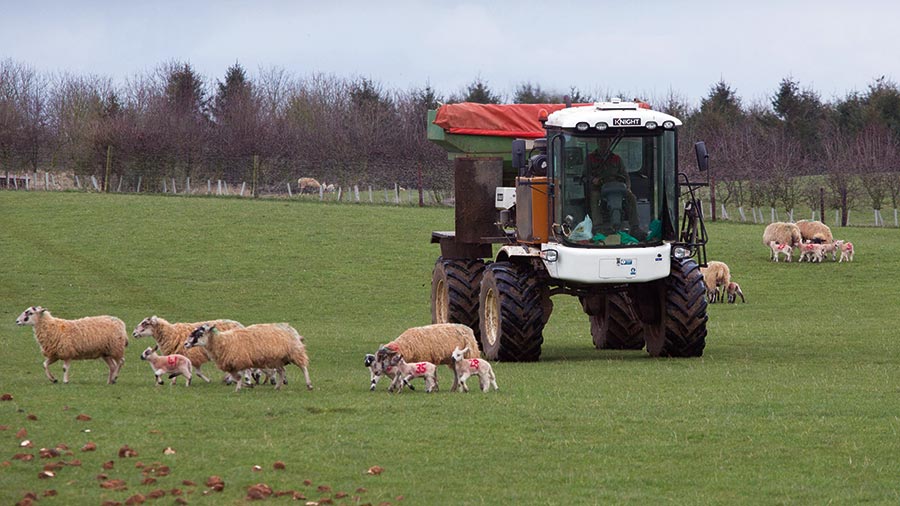5 ways to cut nitrogen use on grazing ground
 © Tim Scrivener
© Tim Scrivener It is possible to reduce rates or eliminate nitrogen fertiliser applications without having a significant detrimental impact on grazed grass growth. But it must be done at the right time and on appropriate fields.
Many producers will be tempted to pull back on fertiliser this season in light of escalating nitrogen (N) prices. However, simply halving application rates could likely see a 20-25% reduction in grass growth.
Instead, it could be more effective to reduce or stop N at certain times of the season, says independent soil and grassland specialist Chris Duller.
In doing so, the grass growth dip could be reduced, while also lowering the annual fertiliser bill.
See also: Options for reducing bought-in fertiliser on livestock farms
Fertiliser trial
In 2020, Mr Duller carried out a trial at Mountjoy, a Farming Connect demonstration farm in Pembrokeshire, to evaluate the impact of reducing N in the summer and autumn.
The farm’s normal rate was applied for the first four grazing rounds – the first had no N, then rates of 30, 30 and 20kg N/ha (12, 12 and 8kg N/acre) were applied.
From July to October, grass either received no N, 18kg N/ha (7kg N/acre) or a half rate of 9kg N/ha (3.5kg N/acre) for each of four grazing rounds.
By not applying any summer or autumn N, total N use for the year reduced by 50%, while total grass growth dropped by just 10% (see table below).
When a half rate of N was applied in the summer/autumn, there was a 6% reduction in grass growth for 25% less total N across the season.
Rates on grazing ground
Mr Duller advises against lowering N rates dramatically on silage ground as this will reduce yields and compromise production. He suggests the following on grazing ground:
1. Reduce N at the start of the season
Look to reduce N applications in February-March when N response rates are lower.
Avoid applying N to poorer ground that will have a lower response such as north-facing fields or those with a low pH or compaction. In these cases, do not apply N until soils are warm.
On good fields, N rates can be reduced by 5 or 10kg N/ha (2 to 4kg N/acre).
Mr Duller says even those producers with a high spring grass demand can drop back, but by no more than 5 or 10kg N/ha.
2. Beware of missing out on peak grass growth
Stick close to full rates through May and June so grass production is not compromised. At this time of year grass measuring is vital – if farm covers are above target there will be opportunities to cut back on N.
3. Drop N from July
By this time, there has already been a build-up of residual N from muck and urine from grazing cows.
Any clover has also begun to fix N. Target high-quality leys with good soils and/or clover for zero nitrogen application at this time.
4. Do not cut N too much on poor ground
Total elimination of N on swards with only 30-40% perennial ryegrass and with no clover should generally be avoided.
“Those will tend to stop completely if we don’t feed them,” Mr Duller says. Instead, drop back by about 5-10kg N/ha (2-4kg N/acre).
5. New leys still require full rate N
Do not cut N on new reseeds as they deliver the best response to N and you will compromise performance.
Impact of halving or halting nitrogen applications from July to October (Mountjoy, Pembrokeshire 2020) |
|||
|
|
No summer N |
Half summer N |
Full N |
|
Total N applied |
80kg N/ha (32kg N/acre) (before July) |
119kg N/ha (48kg N/acre) |
158kg N/ha (64kg N/acre) |
|
Percentage of total N used in season |
50% |
75% |
100% |
|
Cost saving/ha July-September versus full rate N application (34.5%N@£650/t) |
£147/ha (£59/acre) (£1.88 x 78kg N/ha) |
£73/ha (£30/acre) (£1.88 x 39kg N/ha) |
|
|
Total kilos of dry matter produced across season |
14,365kg DM/ha (5,813kg DM/acre) |
15,012kg DM/ha (6,075kg DM/acre) |
15,978kg DM/ha (6,466kg DM/acre) |
|
Percentage of total dry matter production potential |
90% |
94% |
100% |
